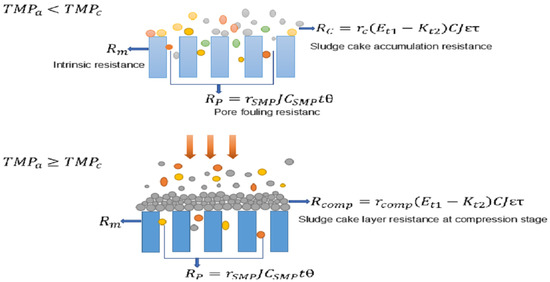Determination of Sustainable Critical Flux through a Long-Term Membrane Resistance Model
Abstract
:1. Introduction
2. Theories and Models
2.1. Components of Filtration Resistance
2.2. Polymer Film Pore Fouling Resistance ()
2.3. Sludge Cake Accumulation Resistance ()
- 1.
- Probability of suspended solids being deposited on the polymer film surface (E).
- 2.
- Probability of the suspended solids detaching from the polymer film surface ().
2.4. Cake Layer Compression Resistance ()
3. Experiments
3.1. Lab-Scale Setup
3.2. Model Parameters’ Determination
3.2.1. Rp and rc
- where is the permeate viscosity, mPa•s. is the concentration of mixed liquor suspended solids, kg/m3. is the effective filtration area, m2. P is the filtration pressure, Pa. is the filtration time, s. is the filtration volume, m3.
3.2.2. Ratio of Boundary Velocity to Bulk Flow Velocity
3.2.3. Temperature Coefficient τ
4. Results and Discussion
4.1. Model Simulation under Different Fluxes in the Lab-Scale A2/O-MBR
4.2. The Determination of Sustainable Critical Flux
4.3. Model Application in a Large-Scale A2/O-MBR Municipal Wastewater Treatment Plant
5. Conclusions
Supplementary Materials
Author Contributions
Funding
Institutional Review Board Statement
Data Availability Statement
Conflicts of Interest
References
- Le-Clech, P. Membrane bioreactors and their uses in wastewater treatments. Appl. Microbiol. Biotechnol. 2010, 88, 1253–1260. [Google Scholar] [CrossRef]
- Shen, Y.X.; Xiao, K.; Liang, P.; Sun, J.Y.; Sai, S.J.; Huang, X. Characterization of soluble microbial products in 10 large-scale membrane bioreactors for municipal wastewater treatment in China. J. Membr. Sci. 2012, 415, 336–345. [Google Scholar] [CrossRef]
- Gul, A.; Hruza, J.; Yalcinkaya, F. Fouling and Chemical Cleaning of Microfiltration Membranes: A Mini-Review. Polymers 2021, 13, 846. [Google Scholar] [CrossRef] [PubMed]
- Chu, H.P.; Li, X.Y. Membrane fouling in a membrane bioreactor (MBR): Sludge cake formation and fouling characteristics. Biotechnol. Bioeng. 2005, 90, 323–331. [Google Scholar]
- Wu, J.; Huang, X. Effect of mixed liquor properties on fouling propensity in membrane bioreactors. J. Membr. Sci. 2009, 342, 88–96. [Google Scholar] [CrossRef]
- Meng, F.; Zhang, H.; Yang, F.; Zhang, S.; Li, Y.; Zhang, X. Identification of activated sludge properties affecting membrane fouling in submerged membrane bioreactors. Sep. Purif. Technol. 2006, 51, 95–103. [Google Scholar] [CrossRef]
- Ji, L.; Zhou, J. Influence of aeration on microbial polymers and membrane fouling in submerged membrane bioreactors. J. Membr. Sci. 2006, 276, 168–177. [Google Scholar] [CrossRef]
- Bouhabila, E.; Ben Aim, R.; Buisson, H. Fouling characterisation in membrane bioreactors. Sep. Purif. Technol. 2001, 22, 123–132. [Google Scholar] [CrossRef]
- Sorm, R.; Bortone, G.; Saltarelli, R.; Jenicek, P.; Wanner, J.; Tilche, A. Phosphate uptake under anoxic conditions and fixed-film nitrification in nutrient removal activated sludge system. Water Res. 1996, 30, 1573–1584. [Google Scholar] [CrossRef]
- Yao, M.; Ladewig, B.; Zhang, K. Identification of the change of soluble microbial products on membrane fouling in membrane bioreactor (MBR). Desalination 2011, 278, 126–131. [Google Scholar] [CrossRef]
- Tian, Y.; Li, Z.; Ding, Y.; Lu, Y. Identification of the change in fouling potential of soluble microbial products (SMP) in membrane bioreactor coupled with worm reactor. Water Res. 2013, 47, 2015–2024. [Google Scholar] [CrossRef]
- Bae, T.-H.; Tak, T.-M. Interpretation of fouling characteristics of ultrafiltration membranes during the filtration of membrane bioreactor mixed liquor. J. Membr. Sci. 2005, 264, 151–160. [Google Scholar] [CrossRef]
- Meng, F.; Yang, F.; Shi, B.; Zhang, H. A comprehensive study on membrane fouling in submerged membrane bioreactors operated under different aeration intensities. Sep. Purif. Technol. 2008, 59, 91–100. [Google Scholar] [CrossRef]
- Hung, T.S.; Bilad, M.R.; Shamsuddin, N.; Suhaimi, H.; Ismail, N.M.; Jaafar, J.; Ismail, A.F. Confounding Effect of Wetting, Compaction, and Fouling in an Ultra-Low-Pressure Membrane Filtration: A Review. Polymers 2022, 14, 2073. [Google Scholar] [CrossRef] [PubMed]
- Field, R.W.; Wu, D.; Howell, J.A.; Gupta, B.B. Critical flux concept for microfiltration fouling. J. Membr. Sci. 1995, 100, 259–272. [Google Scholar] [CrossRef]
- Le Clech, P.; Jefferson, B.; Chang, I.S.; Judd, S.J. Critical flux determination by the flux-step method in a submerged membrane bioreactor. J. Membr. Sci. 2003, 227, 81–93. [Google Scholar] [CrossRef]
- Guglielmi, G.; Saroj, D.P.; Chiarani, D.; Andreottola, G. Sub-critical fouling in a membrane bioreactor for municipal wastewater treatment: Experimental investigation and mathematical modelling. Water Res. 2007, 41, 3903–3914. [Google Scholar] [CrossRef]
- Li, J.; Zhang, X.; Cheng, F.; Liu, Y. New insights into membrane fouling in submerged MBR under sub-critical flux condition. Bioresour. Technol. 2013, 137, 404–408. [Google Scholar] [CrossRef]
- Hwang, B.-K.; Lee, C.-H.; Chang, I.-S.; Drews, A.; Field, R. Membrane bioreactor: TMP rise and characterization of bio-cake structure using CLSM-image analysis. J. Membr. Sci. 2012, 419, 33–41. [Google Scholar] [CrossRef]
- Nguyen, T.N.; Su, Y.C.; Pan, J.R.; Huang, C. Comparison of membrane foulants occurred under different sub-critical flux conditions in a membrane bioreactor (MBR). Bioresour. Technol. 2014, 166, 389–394. [Google Scholar] [CrossRef]
- Xu, R.; Zhang, Q.; Tong, J.; Wei, Y.; Fan, Y. Internal carbon source from sludge pretreated by microwave-H2O2 for nutrient removal in A2/O-membrane bioreactors. Environ. Technol. 2014, 36, 827–836. [Google Scholar] [CrossRef] [PubMed]
- Psoch, C.; Schiewer, S. Resistance analysis for enhanced wastewater membrane filtration. J. Membr. Sci. 2006, 280, 284–297. [Google Scholar] [CrossRef]
- Schwarz, A.O.; Rittmann, B.E.; Crawford, G.V.; Klein, A.M.; Daigger, G.T. Critical review on the effects of mixed liquor suspended solids on membrane bioreactor operation. Sep. Sci. Technol. 2006, 41, 1489–1511. [Google Scholar] [CrossRef]
- Wang, Z.; Wu, Z.; Yu, G.; Liu, J.; Zhou, Z. Relationship between sludge characteristics and membrane flux determination in submerged membrane bioreactors. J. Membr. Sci. 2006, 284, 87–94. [Google Scholar] [CrossRef]
- Janus, T.; Paul, P.; Ulanicki, B. Modelling and simulation of short and long term membrane filtration experiments. Desalination Water Treat. 2009, 8, 37–47. [Google Scholar] [CrossRef]
- Okamura, D.; Mori, Y.; Hashimoto, T.; Hori, K. Identification of biofoulant of membrane bioreactors in soluble microbial products. Water Res. 2009, 43, 4356–4362. [Google Scholar] [CrossRef]
- Li, X.Y.; Wang, X.M. Modelling of membrane fouling in a submerged membrane bioreactor. J. Membr. Sci. 2006, 278, 151–161. [Google Scholar] [CrossRef]
- Metcalf, L. Wastewater Engineering: Treatment and Reuse; McGraw-Hill: New York, NY, USA, 2003. [Google Scholar]
- Li, X.Y.; Chu, H.P. Membrane bioreactor for the drinking water treatment of polluted surface water supplies. Water Res. 2003, 37, 4781–4791. [Google Scholar] [CrossRef]
- Sørensen, B.L.; Sørensen, P.B. Structure compression in cake filtration. J. Environ. Eng. 1997, 123, 345–353. [Google Scholar] [CrossRef]
- Boyle-Gotla, A.; Jensen, P.D.; Yap, S.D.; Pidou, M.; Wang, Y.; Batstone, D.J. Dynamic multidimensional modelling of submerged membrane bioreactor fouling. J. Membr. Sci. 2014, 467, 153–161. [Google Scholar] [CrossRef]
- Li, X.Y.; Yuan, Y. Collision Frequencies of Microbial Aggregates with Small Particles by Differential Sedimentation. Environ. Sci. Technol. 2002, 36, 387–393. [Google Scholar] [CrossRef] [PubMed]
- Feng, S.; Zhang, N.; Liu, H.; Du, X.; Liu, Y.; Lin, H. The effect of COD/N ratio on process performance and membrane fouling in a submerged bioreactor. Desalination 2012, 285, 232–238. [Google Scholar] [CrossRef]
- Qing, Z.; Rongle, X.; Xiang, Z.; Yaobo, F. Simulation and optimization of airlift external circulation membrane bioreactor using computational fluid dynamics. Water Sci. Technol. 2014, 79, 1846–1852. [Google Scholar] [CrossRef] [PubMed]
- Krzeminski, P.; Iglesias-Obelleiro, A.; Madebo, G.; Garrido, J.M.; van der Graaf, J.H.J.M.; van Lier, J.B. Impact of temperature on raw wastewater composition and activated sludge filterability in full-scale MBR systems for municipal sewage treatment. J. Membr. Sci. 2012, 423, 348–361. [Google Scholar] [CrossRef]
- Jiang, T.; Kennedy, M.D.; Guinzbourg, B.F.; Vanrolleghem, P.A.; Schippers, J.C. Optimising the operation of a MBR pilot plant by quantitative analysis of the membrane fouling mechanism. Water Sci. Technol. 2005, 51, 19–25. [Google Scholar] [CrossRef] [PubMed]
- Van den Brink, P.; Satpradit, O.A.; van Bentem, A.; Zwijnenburg, A.; Temmink, H.; van Loosdrecht, M. Effect of temperature shocks on membrane fouling in membrane bioreactors. Water Res. 2011, 45, 4491–4500. [Google Scholar] [CrossRef]
- Wedi, D.; Bleisteiner, S.; Wild, W. Seasonal changes in filterability and permeability shown by the example of MBR-Monheim. In Proceedings of the 8 Aachener Tagung Wasser und Membrane, Aachen, Germany, 27–28 October 2009; pp. A26-1–A26-11. [Google Scholar]
- Martín-Pascual, J.C.L.-D.J.; López-López, C.; Muñio, M.M.; Hontoria, E.; Poyatos, J.M. Effects of temperature on the permeability and critical flux of the membrane in a moving bed membrane bioreactor. Desalination Water Treat. 2013, 53, 3439–3448. [Google Scholar] [CrossRef]
- Fenu, A.; De Wilde, W.; Gaertner, M.; Weemaes, M.; de Gueldre, G.; Van De Steene, B. Elaborating the membrane life concept in a full scale hollow-fibers MBR. J. Membr. Sci. 2012, 421, 349–354. [Google Scholar]
- Guglielmi, G.; Chiarani, D.; Judd, S.; Andreottola, G. Flux criticality and sustainability in a hollow fibre submerged membrane bioreactor for municipal wastewater treatment. J. Membr. Sci. 2007, 289, 241–248. [Google Scholar] [CrossRef]
- Zsirai, T.; Buzatu, P.; Aerts, P.; Judd, S. Efficacy of relaxation, backflushing, chemical cleaning and clogging removal for an immersed hollow fibre membrane bioreactor. Water Res. 2012, 46, 4499–4507. [Google Scholar] [CrossRef]
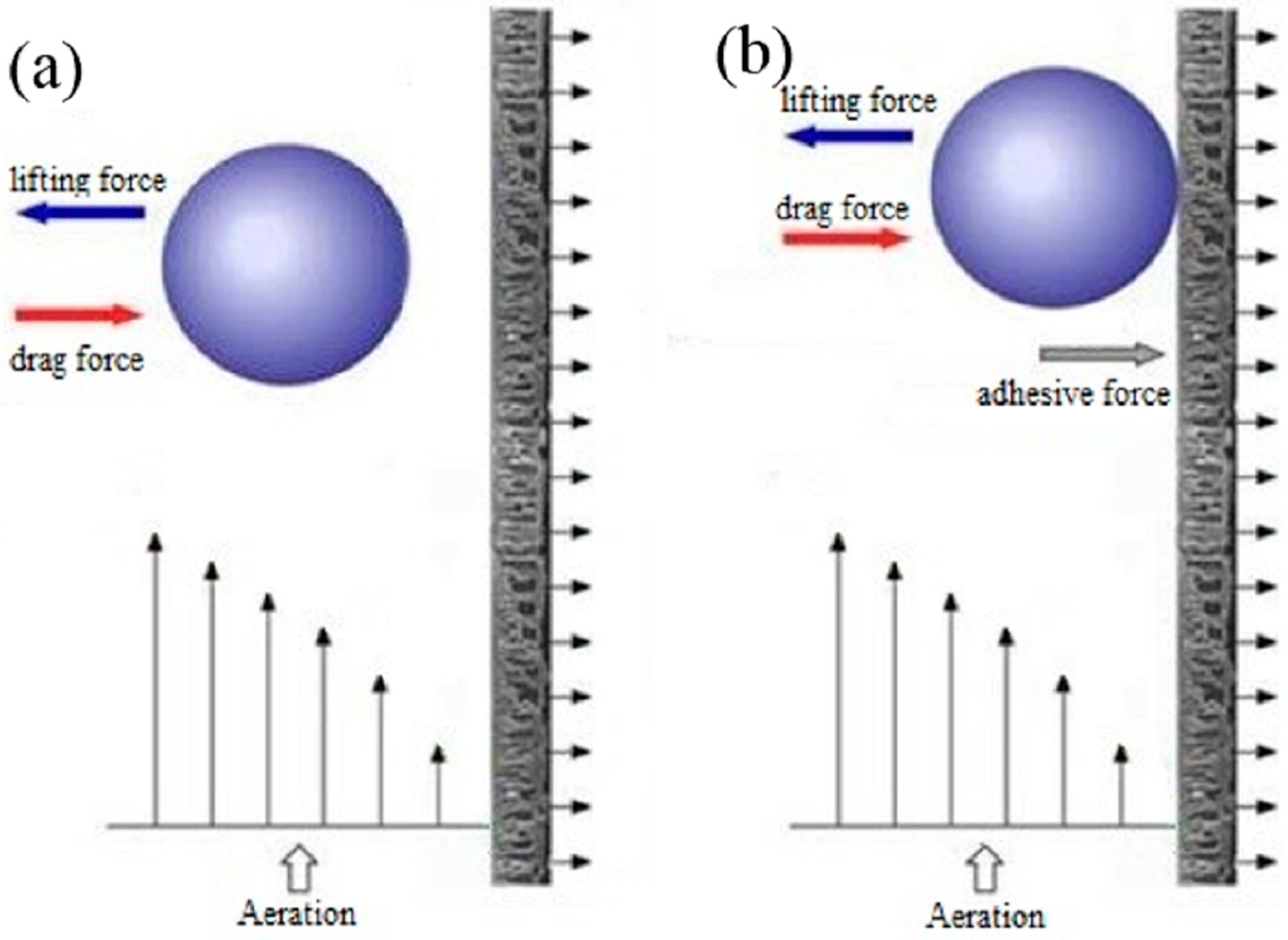
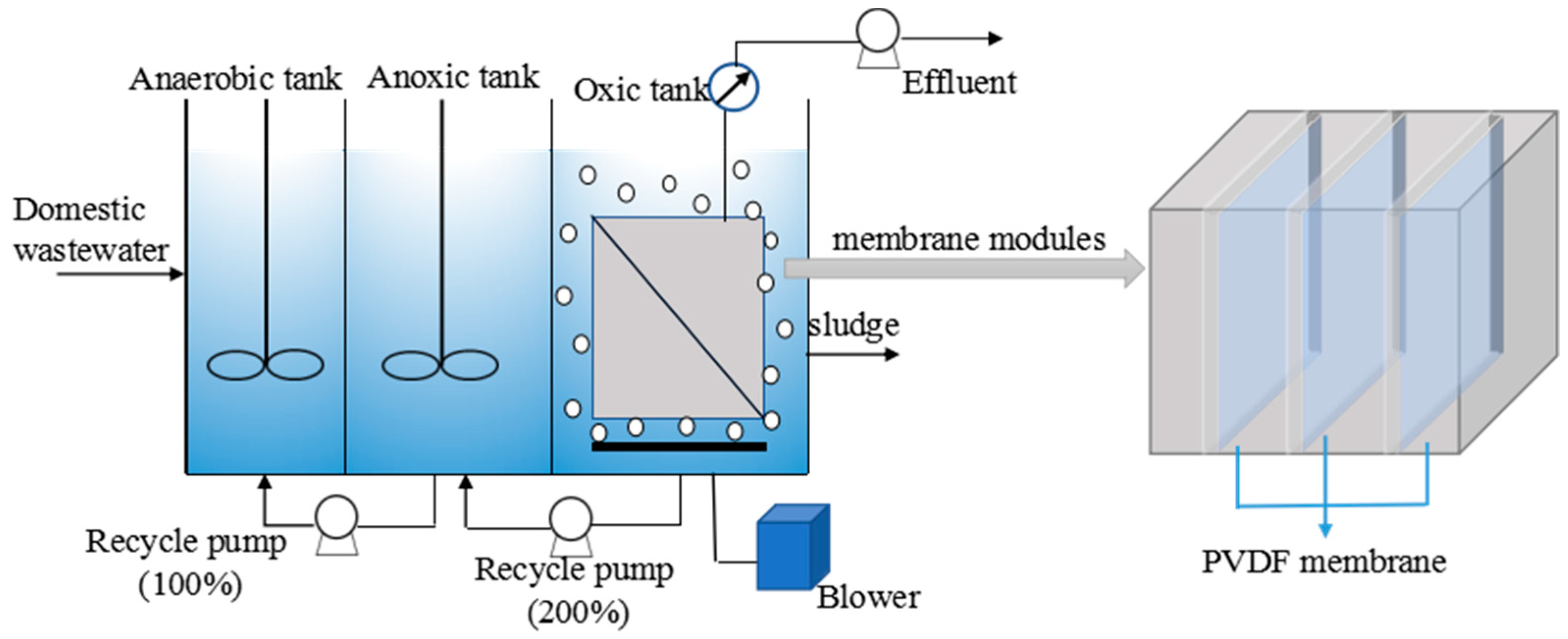
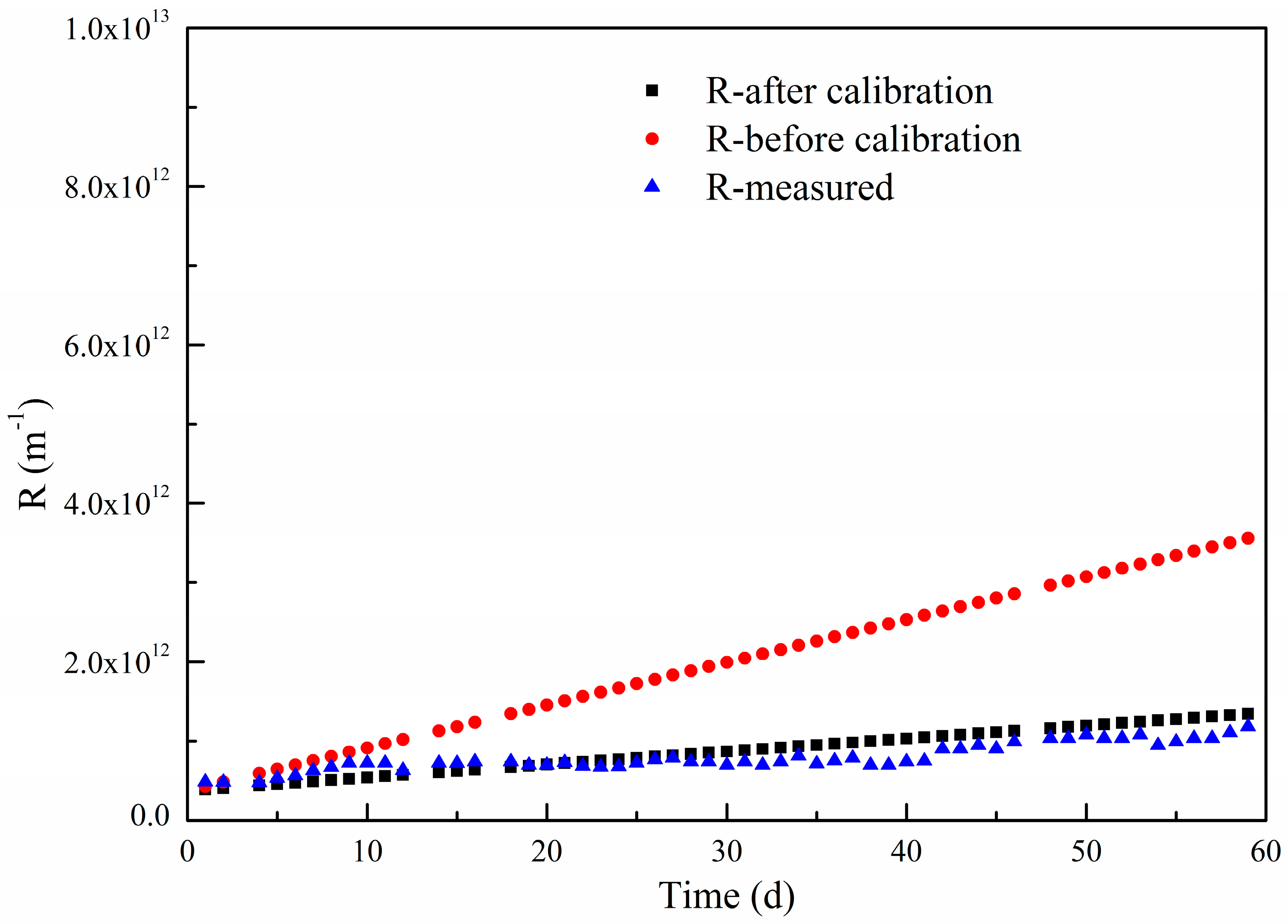
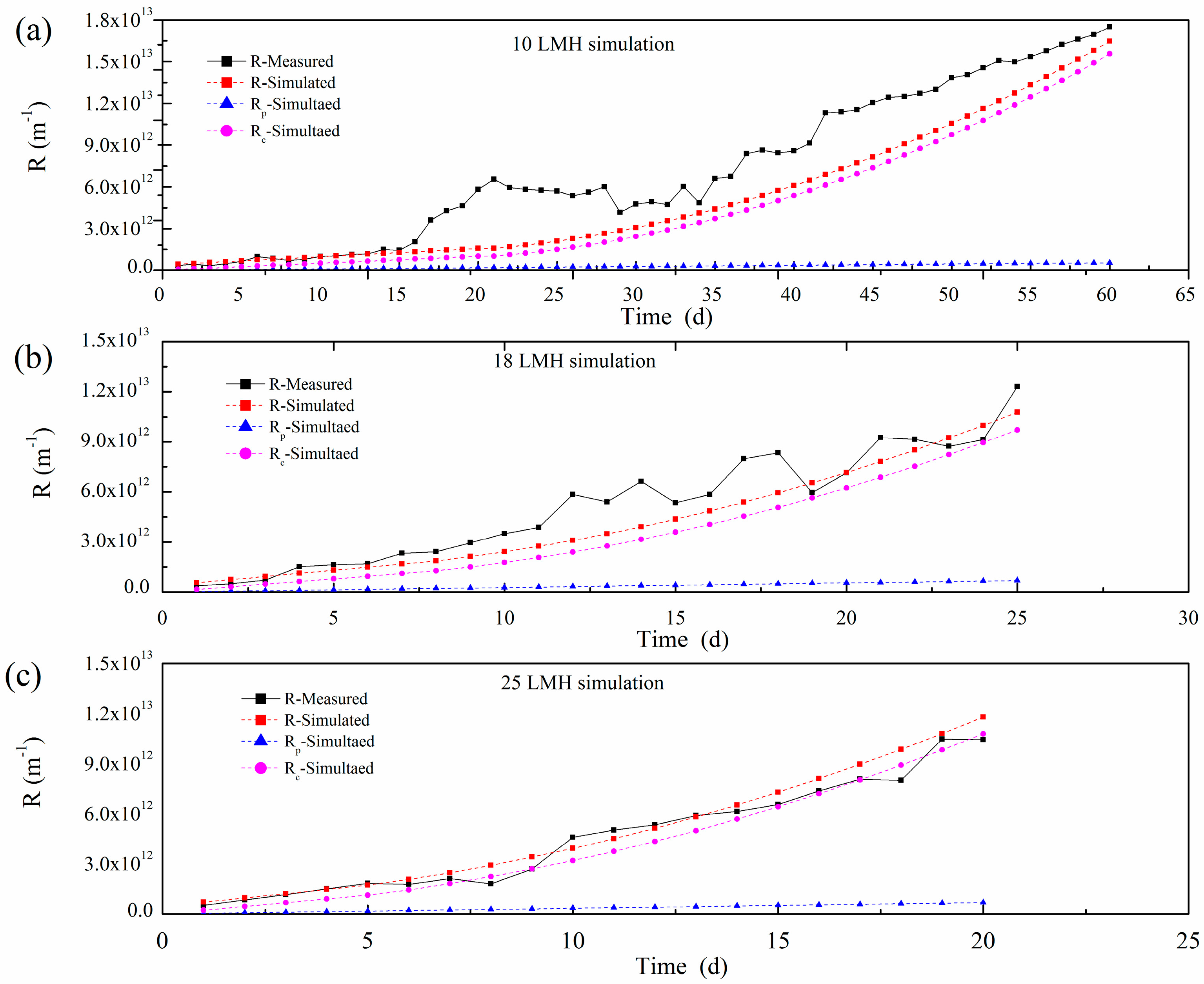

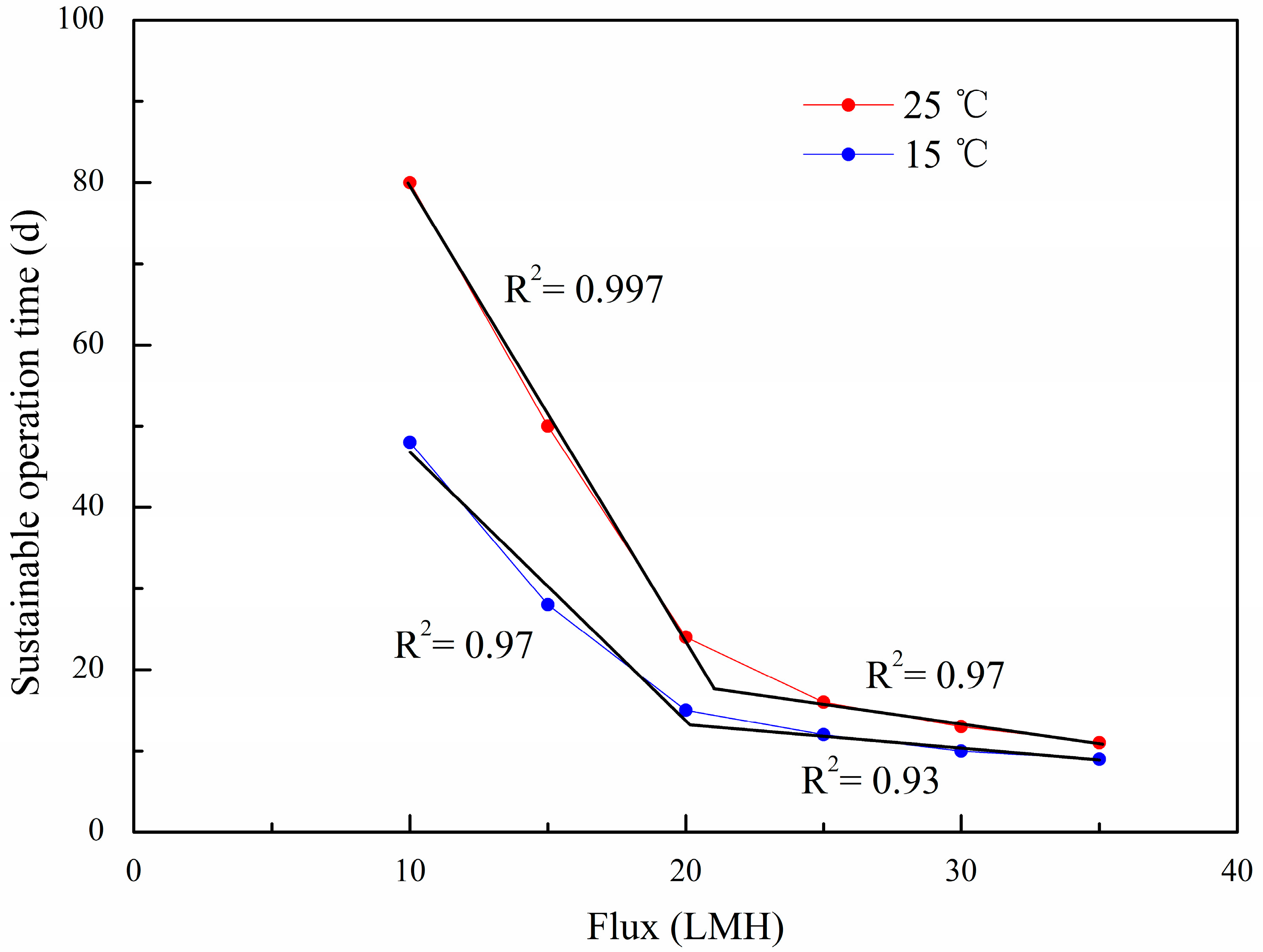
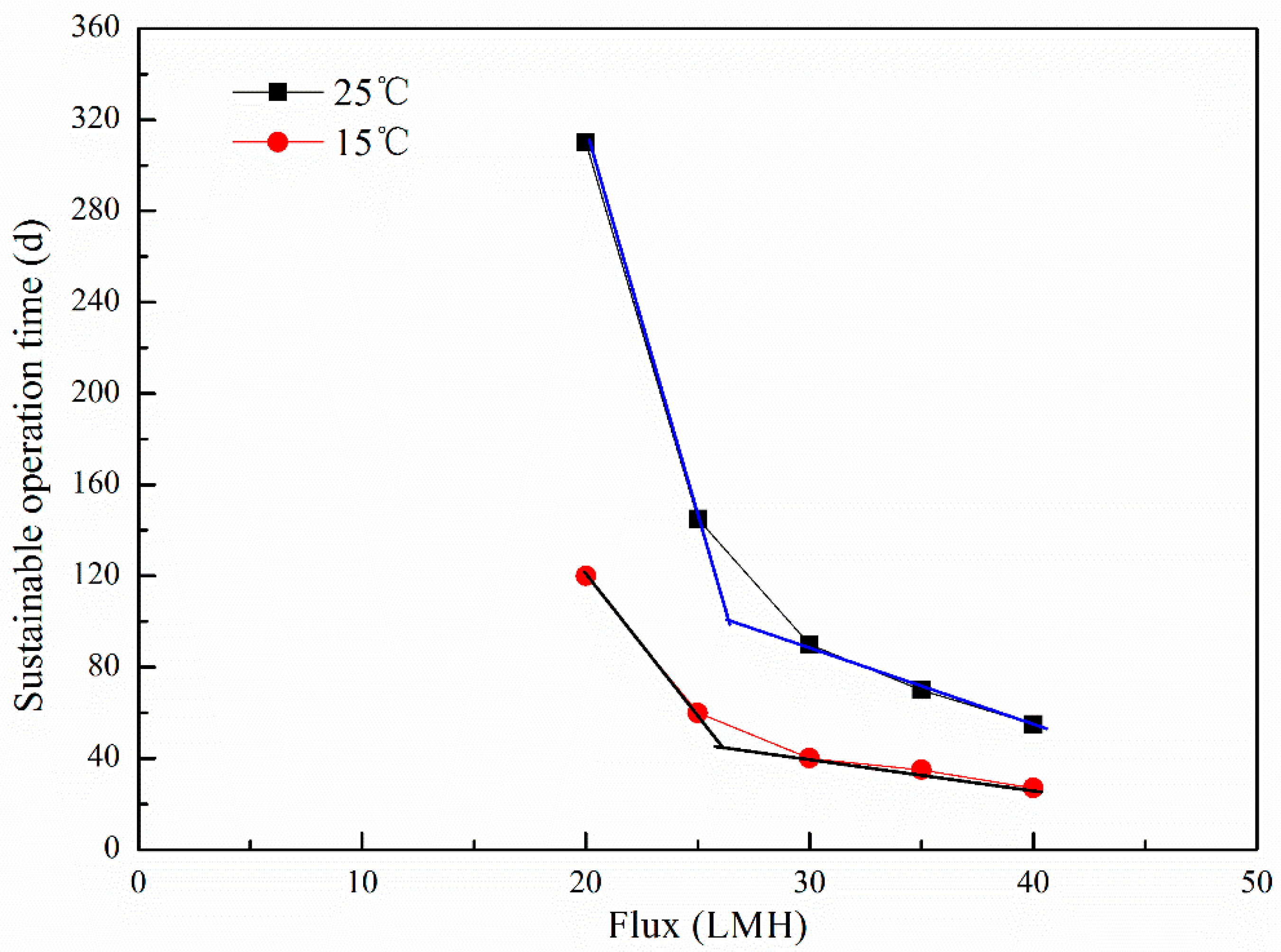
| Measured Value (m−1) | Simulated Value (m−1) | Standard Deviation (%) | ||
|---|---|---|---|---|
| Before Calibration | After Calibration | Before Calibration | After Calibratration | |
| 1.18 × 1012 | 2.73 × 1012 | 1.32 × 1012 | 101.57 ± 63.90 | 7.18 ± 21.86 |
| Symbol | Meaning | Value | Source of Data |
|---|---|---|---|
| C | Sludge concentration, (MLVSS, g/L) | 6.5 | Measured |
| CSMP | SMP concentration, (TOC, mg/L) | 37.7 | Measured |
| g | Gravitational constant (m/s2) | 9.81 | Constant |
| J | Flux (m3/(m2•d)) | —— | Operation parameter |
| K1 | Coefficient (m) | 4 × 10−6 | Constant (from literature) |
| q | Aeration intensity (L/(m2•s)) | 0.83 | Operation parameter |
| Rm | Polymer film intrinsic resistance (m−1) | 3.74 × 1011 | Measured |
| rSMP | Specific pore fouling resistance (m/kg) | 9.1 × 1011 | Measured |
| rc | Specific filtration resistance of cake laye (m/kg) | 3.14 × 1011 | Measured |
| TMPc | Critical pressure (kPa) | 10 | Measured |
| t1 | Filtration time (d) | 6 min filtration and 1 min stop cycle, t1 = 6/7t2. | Operation parameter |
| t2 | Aeration time (d) | Operation parameter | |
| α | Stickiness of biomass particles or stickiness between biomass particles and polymer film surface | At sludge accumulation stage, α = 0.1; at cake layer compression stage, α = 0.5 | Constant (from literature) |
| γ | The ratio of boundary velocity to flow velocity | 0.02 | Constant (from previous work) |
| ε | The percent of sludge practice size less than 100 μm | 0.6 | Measured |
| Viscosity of the sludge suspension (mPa•s) | 5.5 | Measured | |
| Coefficient of polymer film pore clogging caused by SMP | 1.25 at 10 LMH, 1.5 at 18 and 25 LMH | Constant (from previous work) | |
| ρ | Density of the sludge suspension (kg/m3) | 1.0 × 103 | Constant |
| Operational Flux | Measured Value (m−1) | Simulated Value (m−1) | Error (%) | ||||||
|---|---|---|---|---|---|---|---|---|---|
| Rp | Rc | R | Rp | Rc | R | Rp | Rc | R | |
| 10 LMH | 5.9 × 1011 | 1.58 × 1013 | 1.75 × 1013 | 5.30 × 1011 | 1.55 × 1013 | 1.65 × 1013 | −10.2 | −1.9 | −5.7 |
| 18 LMH | 8.7 × 1011 | 1.01 × 1013 | 1.13 × 1013 | 6.84 × 1011 | 9.72 × 1012 | 1.07 × 1013 | −21.4 | −3.8 | −5.3 |
| 25 LMH | 7.3 × 1011 | 9.26 × 1012 | 1.04 × 1013 | 6.78 × 1011 | 1.08 × 1013 | 1.18 × 1013 | −7.1 | 16.6 | 13.5 |
| Parameters | rc (m/kg) | rp (m/kg) | γ | E | K | TMPc (kPa) |
|---|---|---|---|---|---|---|
| High aeration intensity | 2.97 × 1011 | 8.30 × 1011 | 0.01 | 0.125 | 0.059 | 14~15 |
| Low aeration intensity | 0.087 | 0.086 |
Disclaimer/Publisher’s Note: The statements, opinions and data contained in all publications are solely those of the individual author(s) and contributor(s) and not of MDPI and/or the editor(s). MDPI and/or the editor(s) disclaim responsibility for any injury to people or property resulting from any ideas, methods, instructions or products referred to in the content. |
© 2023 by the authors. Licensee MDPI, Basel, Switzerland. This article is an open access article distributed under the terms and conditions of the Creative Commons Attribution (CC BY) license (https://creativecommons.org/licenses/by/4.0/).
Share and Cite
Xu, R.; Fan, Y.; Yang, M.; Song, J. Determination of Sustainable Critical Flux through a Long-Term Membrane Resistance Model. Polymers 2023, 15, 2319. https://doi.org/10.3390/polym15102319
Xu R, Fan Y, Yang M, Song J. Determination of Sustainable Critical Flux through a Long-Term Membrane Resistance Model. Polymers. 2023; 15(10):2319. https://doi.org/10.3390/polym15102319
Chicago/Turabian StyleXu, Rongle, Yaobo Fan, Min Yang, and Jinqiu Song. 2023. "Determination of Sustainable Critical Flux through a Long-Term Membrane Resistance Model" Polymers 15, no. 10: 2319. https://doi.org/10.3390/polym15102319



